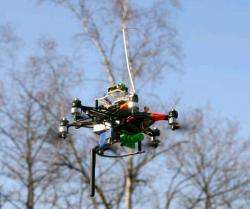The MAV uses lasers and new algorithms to estimate its relative position, build a map, and locate a clear path. Image credit: MIT Robust Robotics Group.
(PhysOrg.com) -- During the last several years, researchers have been building micro air vehicles (MAVs) that can autonomously fly through different environments by relying on GPS for navigation. Recently, a team of researchers has designed an MAV that can navigate unknown environments without GPS, which could enable it to overcome several limitations of GPS-dependent vehicles.
The new MAV is being designed by the Robust Robotics Group at MIT's Computer Science and Artificial Intelligence Laboratory. Their work is motivated by the fact that, in some places, such as dense urban environments or indoors, GPS is noisy and maps are unavailable, which can cause MAVs to get lost, fly into dangerous regions, or collide with obstacles. Providing MAVs with a tool other than GPS to navigate these environments could help the vehicles avoid these problems.
More information and videos: MIT's Robust Robotics Group
© 2009 PhysOrg.com






















